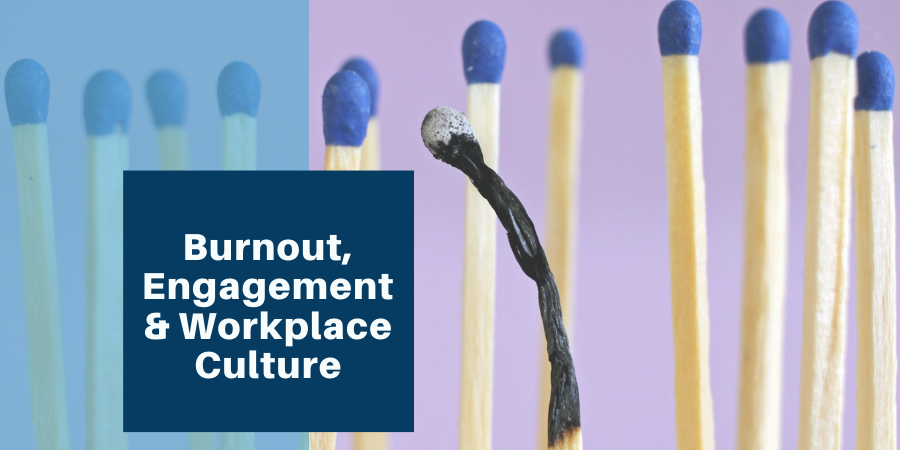
If you find yourself feeling exhausted due to workplace burnout, you are not alone. Perhaps you experience some, all, or many of the following; long hours trying to and work/parent/live in the same space, political or economic uncertainty, pandemic related health concerns (could be physical or emotional), feeling isolated, and so many more. Some days it can feel hard separating home life from work life.
Workplace well-being expert Mandy O’Neill is a professor at George Mason University School of Business and a senior scientist at the University’s Centre for Advancement of Well-being. In this podcast shared on Harvard Business Review, O’Neill shares some signs of burnout as well as some antidotes and ways to protect ourselves from experiencing the emotional exhaustion, stress, and burnout.
O’Neill describes burnout as depersonalization and numbness, a lowered sense of personally being able to accomplish what you want to. People can keep going with chronic burnout to some extent, but it is not the version of ourselves we’d want to see or something we’d want for anyone we care about.
In the Workplace, Engagement is the Opposite of Burnout
The flipside of burnout, says O’Neill, is engagement. Engagement goes up when burnout goes down. We all want to be engaged in our work and in our lives in general, so even though it is possible to keep going with burnout, it benefits our organizations and the individuals within them to create small positive steps to reverse any signs of disengagement. This Forbes article highlights 11 possible red flags that you may have an employee that is struggling with disengagement. This may be as a result of burnout, so if your noticing declining quality of work, negative or quieter behaviour, less involvement, debate, or enthusiasm in team meetings, it may be time for the leader to have a one-on-one conversation so together a plan to correct and support the employee can be made together.
Nurturing a Healthy and Well-Functioning Culture is Consistent – Remote or In-Person
According to this Gallup article, if your workplace culture functioned well in a traditional workplace, Gallup suggests staying consistent with your culture instead of trying to create a new one with your remote teams is important, even if remote work is a bigger part of your long-term strategy.
Culture isn’t dependent on whether employees are remote or in-office, potentially how culture is delivered might need to change, but beliefs of the organization must be consistently upheld. For both in person and remote employees, it is important to maintain a shared culture that promotes strong employee relationships, collaboration, and trust among all employees. How that happens might need to look different considering in person or remote, but the values should remain.
Gallup studies indicate that organizations are most effective at creating a shared culture (remote and in-person) when they:
- Align the (virtual, hybrid and in-person) employee experience with workplace culture.
- Identify moments that matter in each mode of work.
- Create the change that is necessary for a shared culture.
COVID-19 has stress-tested our organizations and every person in ways no one expected. It also has allowed us to see more clearly where we struggle to create a positive and engaging environment (especially as we navigate a growing remote workforce). We may not have been able to see these fractures before 2020.
What are the ways that you can align the employee experience regardless of where their office is? Are their additional or different delivery methods for support needed? These are important considerations when we want to support and continue to engage our employees.
RELATED: Social Interaction and Well-Being. Creating Balance for Virtual Teams.
Small Steps to Reverse Burnout Personally
A few small positive steps any of us can take that O’Neill lists to combat burnout are;
- a good night’s sleep
- keeping a personal board of advisors who can tell us when we are off
- good belly laughs
- helping others (it has a positive side effect of helping us feel better and growing our gratitude)
This article on meditation suggests different types of meditation based on your personality type and might be another small step to reverse any signs of burnout.
Striving for an Engaged Workplace Culture
Overall, stopping to listen to your body and continuing to grow your awareness and compassion for what you’re feeling (or numb to feeling) is the first step to making a plan that will help you build some guard rails and get back to feeling engaged personally. What are the guardrails or delivery methods to protect and grow engagement and resiliency in our organizations? Having this conversation with your team is a good start.
FREE EVENT: Take away some ideas on how to keep your teams motivated, connected and engaged. Register for our Showcase Virtual Preview Event
How We Can Help
High-Performance Teamwork is a training workshop that can support that deliberate conversation. Potentially a multi-module workshop, Summit comes alongside teams to design and deliver content that supports teamwork, sets some guardrails to maintain positive culture, delivers tools for engagement, and spends time building team relationships. Connect with Summit to get started. It is not too early to start 2021 off on the right foot.

